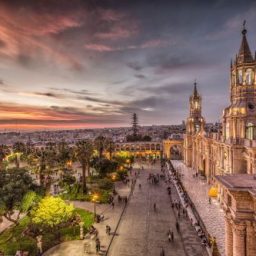

Mexico, a country of historical wealth, is home to fascinating cultures that create a complex and vibrant linguistic landscape. Spanish, together with indigenous languages, dialects, and accents, tells a captivating story of Mexico’s past and present.
From the ancient roots of the Maya and Nahuatl languages to Spanish, Mexico’s linguistic panorama serves as a testament to the resilience and adaptability of its people. Along the way, we will uncover the challenges and triumphs faced by minority languages, as well as the efforts to preserve and revitalize these linguistic treasures.
LANGUAGES OF MEXICO
Spanish is the most popular of 69 languages spoken in Mexico; 68 of them are indigenous tongues used by minority populations. That comes up to 11 language families and 364 local varieties currently being used in the country (source: Heraldo de Mexico).
THE SPANISH LANGUAGE IN MEXICO
Mexico, the most populous Spanish-speaking country in the world, has a long history of the Spanish language, beginning in the 16th century. From its introduction during the colonial period to its status as the official language of modern Mexico, Spanish has played a significant role in shaping the nation’s culture and identity.
MEXICAN SPANISH
Mexican Spanish is characterized by several unique features that differentiate it from European Spanish and other Latin American dialects. It incorporates a significant number of indigenous words, particularly from Nahuatl. These words are used to describe local flora, fauna, food, and customs. Examples include chocolate (from Nahuatl xocoatl), aguacate (ahuacatl), and tamal (tamalli).
Although Mexican Spanish generally follows the same grammatical rules as standard Spanish, there are a few regional peculiarities. For instance, the use of ustedes (plural form of “you”) is preferred over vosotros (used in Spain), and the diminutive suffix -ito/-ita is commonly used to convey affection or informality (e.g., perrito for “little dog”).
Mexican Spanish is known for its clear and relatively slow pronunciation compared to other Spanish dialects (especially the American ones!). One notable feature is the seseo, which means that the letters “s” and “z” are pronounced in the same way (as the English “s” sound).
LANGUAGE REGIONALISMS
Mexico is a large country, and its Spanish dialects vary from region to region. Some of the most distinctive regional accents include:
- Northern Mexican Spanish is characterized by its strong, rhythmic intonation and the pronunciation of the letter “s” at the end of syllables as a soft “h” sound (e.g., pescado pronounced as “peh-cah-do”).
- Central Mexican Spanish is present in Mexico City. It is recognisable by its clear pronunciation and the use of the “ch” sound for the letter “y” (e.g., yo pronounced as “cho”).
- Yucatecan Spanish features a sing-song intonation.
MEXICAN SPANISH GLOBALLY
Mexican Spanish has made a significant impact on mainstream media, particularly in television series and movies. The rise of popular Mexican telenovelas and series, such as Corazón Salvaje, Rebelde, and Quién mató a Sara, as well as films like Amores Perros and Y Tu Mamá También, has introduced the distinct sounds and expressions of Mexican Spanish to a global audience.
Do you need to translate your website’s content to a Mexican variation of Spanish? We will appoint our experienced Spanish translator, who has lived in Mexico and has a strong connection to the local culture, for this task.
NAHUATL LANGUAGE
Nahuatl holds a significant place in the country’s linguistic landscape. Once the language of the mighty Aztec Empire, it continues to be spoken by approximately 1.5 million people, primarily in central Mexico. While the language has faced challenges due to the dominance of Spanish, recent efforts to promote and preserve indigenous languages have led to a renewed interest in Nahuatl. Today, the tongue serves as an invaluable link to Mexico’s pre-Hispanic past, and its influence can be seen in numerous Mexican Spanish words, place names, and cultural expressions.
HISTORY OF NAHUATL IN MEXICO
Nahuatl originated in the 7th century in the present-day central Mexico, among the Nahua people. Later, it became the common language of the Aztec Empire and thrived until the arrival of the Spanish in the early 16th century. This event marked the beginning of a decline in Nahuatl’s prominence, as Spanish became the dominant language.
CHARACTERISTICS OF NAHUATL:
Nahuatl is an agglutinative language: its words gain complex meaning by joining multiple morphemes (meaningful units). Verbs incorporate multiple prefixes and suffixes to convey additional information, such as tense, person, and number. There is no grammatical gender; instead, the language uses a complex system of noun classes. Many words from Nahuatl have permeated to English through Spanish. Some examples are: “tomato”, “chocolate”, and “coyote”.



MAYA LANGUAGE
The Maya language has its roots in the Proto-Mayan language, which is estimated to have been spoken around 5,000 years ago in today’s Guatemala and south-eastern Mexico. The Maya civilization reached its zenith during 200-900 AD. Their script emerged as one of the most sophisticated writing systems in the pre-Columbian Americas. It was used to inscribe monumental stone carvings and pottery, documenting historical events, religious beliefs, and the lives of the ruling elite.
The Spanish conquest brought a decline in the use of Maya languages, as Spanish became the dominant language in the region. However, Maya languages persisted and continued to be spoken. Today, there are around 5 million speakers of the Maya languages in Mexico (source: Naatik Mexico). Efforts have been made to preserve and revitalize these languages, including promoting their use in education and media.
MAYAN LANGUAGE FAMILY
In the 16th century, the Maya language family comprised around 30 languages, used by indigenous people in today’s Guatemala, southern Mexico, Belize, and western Honduras. They can be grouped into several branches, such as Yucatecan, K’ichean, Q’anjobalan, and Cholan-Tzeltalan. These languages are often mutually unintelligible.
Maya languages have a rich and intricate verb system, with multiple aspect, mood, and tense distinctions. Verbs are marked for person and number, typically with both prefixes and suffixes.
ZAPOTEC LANGUAGE IN MEXICO
The Zapotec civilization was one of the earliest and most influential Mesoamerican cultures. They developed a hieroglyphic writing system. Like with other languages, the arrival of the Spanish in the early 16th century marked a decline in its use. Today, there are slightly more than half a million speakers of Zapotec languages, primarily in the state of Oaxaca (source: the 2020 census).
Zapotec is not a language, it is a group of around 50 languages and dialects. Many of them are tonal: the pitch of a syllable can change the meaning of a word. They are agglutinative, and feature rich phonetic systems.
Are you looking for skilled speakers of international languages for an international corporation? Save a link to Focus Audit Tool: a software that quickly and efficiently tests language level.
LOCAL LANGUAGES: INITIATIVES
Mexico has taken many initiatives to preserve and promote indigenous languages, both at the federal and local levels. 2003 was a milestone year. The government established Ley General de Derechos Lingüísticos de los Pueblos Indígenas, a law to protect indigenous people and their linguistic rights. As a result, the National Institute of Indigenous Languages emerged. The INALI conducts research and promotes the language variety through a range of educational events.
TIME TO DISCOVER MEXICO
In Mexico, languages play a crucial role in shaping the cultural and social identity of the nation. Their richness and diversity can be seen at every turn, as soon as you venture into the less-touristic parts of the country. Allow yourself to be surprised by the hospitality of the locals, the rich cuisine, and the vibrant local colour.
Remember to take care of your safety. We strongly recommend learning the basics of Spanish and planning the trip in advance. Regardless of your language skills, if you are a complete beginner or an advanced learner, our Spanish course will prepare you for many situations you may encounter during your travels.















